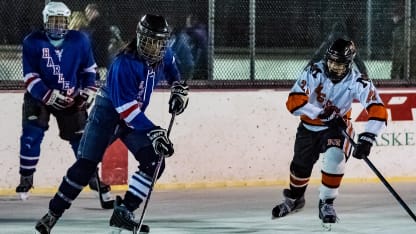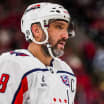NEW YORK --The fourth floor of the Oberia D. Dempsey Multi-Service Center is quiet on this Tuesday night. Outside, there is a mix of freezing snow and ice that will close the Central Park ice skating rink and impact hockey practice for dozens of kids in the Ice Hockey in Harlem program on Wednesday. But for now, a few hearty souls have made it into the unassuming building on West 127th Street for a class that is anything but normal.
Ice Hockey in Harlem has impact beyond rink
Program giving kids chance to play sport, learn life lessons in New York City neighborhood

They sit at two tables at the front of the beige cinderblock classroom, nametags on, facing a chalkboard that has "Black History Month" already written on it. But this class is not about Martin Luther King Jr. It does not touch on Harriet Tubman or Frederick Douglass.
Instead, it is about Willie O'Ree.
Craig Stanton stands at front of the room, facing the kids and asks a simple question. He has mentioned Jackie Robinson and, so, he quizzes them: "Why is he famous?"
Six hands shoot up. They know he is a baseball player. But it takes a girl in braids, a pink parka slung over the back of her chair, to identify the more important point, that he was the first black baseball player to play in the Major Leagues. Which, of course, brings Stanton to O'Ree, the first black player in the NHL. He writes O'Ree's name on the board.

This is the most unusual part of an unusual program, in which kids from Harlem are introduced to a sport more associated with prep schools in New England, high school kids in Minnesota and Canadian kids from Halifax to Vancouver. It's not only about learning to skate or the intricacies of the game for the kids of Ice Hockey in Harlem. It is also nights in the Dempsey Center for a hockey knowledge class that teaches Black History Month through the career of O'Ree, who has visited the program and worked with the kids numerous times throughout the years. It teaches geography through the locations of the NHL teams, and math through standings and statistics.
When the kids of Ice Hockey in Harlem, who start in the Learn to Skate program as young as 5, reach 9 or 10, they are introduced to this class and to Stanton, who is a board member at Ice Hockey in Harlem. He has taught Hockey Knowledge for 25 years, becoming involved with the program soon after his good friend Todd Levy co-founded it in 1987.
Because it's not just about the hockey.
Ice Hockey in Harlem is "a free ice hockey and academic enrichment program open to children from Harlem and upper Manhattan," said Brad Preston, who has been the program director for seven years.
Preston emphasizes that families do not have to pay a penny out of pocket, even for expensive hockey equipment.
"The purpose is to expand our students' educational opportunities and life experiences through participation in the sport of ice hockey, in addition to opening access to a sport that traditionally had been closed to people of limited economic means or people of color."
They do it through a speaker series for older kids, through the college exploration series for the oldest, through the Hockey Knowledge class. The latter starts with the basics; the equipment, understanding the rink -- the blue line, the red line, the circles, the crease -- understanding penalties, and the history of hockey.
The history of hockey is where they are on this Tuesday in February, as they study O'Ree.
The girl pipes up again.
"What's kind of important is that he never gave up," she says.
Stanton nods. This is one of the key points he is trying to make.
At one point, Stanton mentions that O'Ree's team played a 70-game season, but O'Ree missed half a dozen games: How many did he play?
It takes a few tries, but eventually a boy gets the answer. Stanton flips him a hockey trading card face down, the reward for a correct answer. The kids are prohibited from righting their cards, seeing who they've gotten. They will earn cards for the right responses or be penalized cards for wrong ones or talking over each other or not paying attention. Each kid has a stack of varying size, a relic of another time, yet still undeniably enticing for a 10-year old.

After going through O'Ree's biography, Stanton moves on, to an assessment of the NHL's diversity. How many black captains have there been? How many black coaches? How many black players in the Hockey Hall of Fame? And from there to the diversity of other nationalities, to the total percentages of players from Canada and the United States, from Russia and Sweden and Finland. He shows them how the League is changing, all while throwing out questions: What New York Rangers player is from Norway? Do you know who Wayne Gretzky is?
A kid shakes his head no to the Gretzky question.
As Stanton acknowledges, it's all a work in progress.
\\\\
The early years were rough. The Ice Hockey in Harlem founders had an idea for a program, and a concept of how it might work. But at the beginning, they didn't have the kids.
It started, in 1987, as a business school thesis by Dave Wilk, the dream of a philanthropic program that would teach Harlem kids to skate and play hockey, that would enable them to participate in an expensive sport without spending a dime.
Todd Levy, then 19, joined Wilk after several weeks. He stayed when Wilk left the program to head up the then-Disney funded GOALS program -- Growth Opportunities through Athletics, Learning & Service -- in California in the early 1990s.
"The first couple of years we were begging kids to play, honestly," Levy said. "That's just a fact. It was not the high-profile popular sport that it has become. It was like a marketing and sales mission. We would go into inner-city schools and we would show them a hockey bag and tell them why it's a great sport and they should try it. It was really a bit of a door-to-door sales pitch."
They started with kids between 10 and 12, which was a difficult age to learn to skate. They had anywhere between nine and 22 kids on the ice at a time that season, according to Levy, a number that rose to 40 in the second year and 80 in the third before ballooning from there. Today, there are 250 to 260 kids, from ages 5 to 18, involved. Each participant is chosen through an application process that weighs household income, location and the educational level of the parents. Thirty-one percent of their players are female, a number the program hopes to increase.
"Those first few years we were using a lot of borrowed equipment, a lot of old equipment from other people," Levy said. "I think I even have photographs of kids not wearing cages, [wearing] these little bucket helmets."
They struggled to find their place, to stay alive.
It became less of a struggle in 1988. That was when Gretzky came to visit.
Gretzky and some teammates from the Los Angeles Kings went to Central Park's Lasker Rink, still the home of Ice Hockey in Harlem, on Dec. 11, 1988, during a visit arranged by Wilk and Pat Hickey, a former Rangers forward. The coverage was widespread, as Levy remembers, and it got their name out there, their mission. It introduced them to the hockey world.
It helped.
But it has never been easy for Ice Hockey in Harlem, even though it has gotten easier. The organization remains streamlined, toggling between two and four full-time paid staff members, bolstered by approximately 75 volunteers. The budget is still shoestring, and the dreams are tempered by that reality. Ice Hockey in Harlem is mostly funded by private donations, many of which come from their three big events each season: the Benefit on the Green golf and tennis outing in August, the Winter Sports Celebration gala in February, and the Lawyers' Cup hockey tournament in March. The organization also gets an annual grant from the NHL as part of its affiliation as a Hockey is for Everyone program and is supported by the New York Rangers' alumni organization.

"We're still in a position where we are a family living paycheck-to-paycheck," Levy said. "We probably live year-to-year or so, year and a half at a time. We're not an organization with millions and millions of dollars in the bank and that's maybe one of my bigger disappointments."
One room at the back of the tiny offices at the Dempsey Center is filled with equipment, the gear occupying much of the room. It is almost all donated, coming from families whose kids are off to college with no more hockey in their future, from opponents who run equipment drives, from Jewish New York residents who round up gear as part of their bar or bat mitzvah celebrations.
Helmets are more difficult to keep in stock because of the five-year expiration dates. Shortages of smaller-sized equipment for the 5- and 6-year-olds are common. There is never enough goalie gear.
They make do. They find what they need and buy what they can.
"We're fine using used equipment, but to me a big part of it is dignity," Preston said. "I don't want people to have to use mismatched equipment or stuff with holes in both sides. There are plenty of times we get a donation in the morning and put the pair of skates on somebody that night."
The ability to have their own rink is still a dream, especially one where they can host other teams, difficult now because Lasker Rink lacks boards. Instead, it has only fencing between the two rinks and behind each goal. The hope is maybe in five years it could be a possibility, though the cost of real estate in New York City never makes anything simple.
But the program will need to at least find a temporary new home rink after the 2020-2021 season. Lasker Rink is temporarily closing for renovations.
They will make it work, they know, as they always have.

Still, Levy believes that there is an even greater impact to be achieved. Aspirations have had to be shelved, wants given way to the day-to-day needs.
Whatever the struggles, though, they fade away when Levy and the program look at their successes.
Like Malik Garvin.
\\\\
Garvin, a graduate of Ice Hockey in Harlem, studied accounting and finance in college.
He worked on Wall Street, and then transitioned to a financial planning firm in Westchester County, New York. But he didn't feel that the job was quite right for him, for what he wanted out of his life. When he saw an opening at a fledgling program called Bronx Lacrosse, he jumped at it.
He was their first hire.
This, after all, seemed right for Garvin. He had grown up in Ice Hockey in Harlem, the youngest kid ever to be allowed to join, following the footsteps of his brother, Roger Graham, who was eight years his senior.
Levy had taken a liking to the 3-year-old, who was perpetually around the rink, clip-on roller blades on his feet, always angling to play with the bigger kids.
"I have memories from that young of different rinks, of different trips," Garvin said. "Bring my mini-stick along, using soda caps in the rinks, too young to even watch the game. Just wanted to play. I was just obsessed with it. … I was so young I didn't realize demographics or anything. I was just in love with the sport."
The program took Garvin to boarding schools in Connecticut and in Maine, to hockey camps and, eventually, to Western New England University, where he walked on to the Division III hockey team as a forward during his senior season.
Ice Hockey in Harlem gave him things that he never would have had without hockey. He wanted to pass that on.
"I'm 25 and I'm just not as satisfied as I feel like I should be, waking up for work every day, not as motivated," Garvin said. "I knew that if I did something I really, really loved, it would bring out the best in me."
He works with kids now, kids who never did their homework, who got passed through the public-school system. Kids whose futures were not as expansive as they should have been.
Much in the way that Ice Hockey in Harlem works, his program uses lacrosse to motivate its kids academically. They give the kids equipment, take them on trips, show them what can be.
"It's kind of come full circle," Garvin said.
He knows the lessons he learned, the ways in which his eyes were opened to the possibilities. He knows that, for so many kids, life would have been far smaller without these programs and he wants to pass those opportunities to others as they were once passed to him.
He sees it in the former participants of Ice Hockey in Harlem who post about their Rangers fandom on Facebook, in the friends whose lives have altered because of opportunities gained, and in the friends whose lives were not.
"All the guidance of the program, it was pretty self-explanatory that if you weren't a good student, if you weren't a good person, then you just weren't going to be a part of it," Garvin said. "It set me on the straight and narrow. And ultimately changed the trajectory of my life.
"That's what it did: It changed the trajectory of my life. I can't really imagine my life without Ice Hockey in Harlem."
\\\\

It's late on a Friday, nearing 10 p.m., at Lasker Rink. The lights are on, the music blares. A group of hockey parents stands by the side of the rink, chatting and laughing above the sounds of hockey; the scrape of skates on ice, the sound of pucks pinging off posts.
The program has back-to-back-to-back practices on Fridays, as squirts give way to pee wees, who then give way to bantams and midgets. There are drills at the start of the practices, work on skating backward in pairs as one player pulls the other by means of two hockey sticks, work on defensive plays, work on the details of the game. There are scrimmages at the end, the favorite part for many of these players, most of whom never gave hockey a thought until they gave it all their thoughts.
That was Malachi Cotman, who, as a precocious 5-year-old, read a flyer on the wall as his mother, Shenique Bruce, was visiting friends at another building in the city five years ago. Bruce, originally from St. Croix, was a fan of figure skating, the legacy of Nancy Kerrigan, the elegance appealing to her. She knew nothing about hockey.
But her son's interest was piqued and Bruce, like many parents in New York City, was looking for a way to get her kid out of the apartment and into a sport during the long winters. Football was too aggressive and basketball wasn't right and, somehow, hockey called to him. He dove in.
It's a process that Preston has watched over and over, as the families first learn of the program. At the beginning, they're "excited -- hopeful but nervous." They worry then, about affording the equipment or isolation, given their ethnicity or country of origin. Preston often must reassure them.
"Parents really can't believe that, yes, we also supply all of the hockey equipment and uniforms," said Preston, adding that about half the parents of IHIH's participants were born outside of the United States, spread among nearly 50 countries, mostly in the Caribbean, South America and Africa. "Yes, we teach them how to skate in their first season. No, they won't be the only Dominican or African-American or Mexican-American player. Nearly all of the children are children of color.
"So, all of a sudden it becomes a much more inclusive place where -- it may sound a bit cliché -- but it really does feel like a family."
That's evident as Dalila Erby wonders aloud if she'll be available to take her brother, Jaysean, to a potential opportunity that might be coming up for Ice Hockey in Harlem, the chance to skate at Madison Square Garden at the beginning of March. One of the mothers jumps in, quickly, to say that she could pick up all of the kids. She could make it happen for them.
That's what they all do to make it here multiple times a week, to practice and hockey class and games. Erby, 28, has been in charge of that for 11-year-old Jaysean for the past four years, since she signed him up without their parents' knowledge after passing on her own love of hockey to her brother. She knew their parents wouldn't be able to afford hockey for him, once she understood the costs, and still, she was determined.
Now it's their brother-sister bonding activity, a lifeline for a kid who has blossomed since joining the program as a reserved 7-year-old.
"Sometimes my threats are like, you don't do your homework, I'm not taking you to practice on Friday," Erby said, with a laugh. "Everything is done immediately."
He talks now. He interacts. Jaysean opens up in ways he never did before.
Much of it about hockey.
"I get how unique it is, how special it is, but some people might have no idea," Garvin said. "No idea that because of this program there's generations of minorities that love hockey and are obsessed with hockey and who dreamt of going to the NHL."
\\\\

But that's not really the point. The love for hockey, yes. The idea that some of their players will make it to the highest levels of hockey? That has never been what Levy or Wilk or Preston or Stanton was after, though they have watched a handful go on to play college hockey.
They want, instead, to open the eyes of the kids to possibilities they might not have entertained before, to invite a world beyond Harlem into their lives. They want to give them safe spaces and exercise, and a little bit of knowledge they might find nowhere else.
"It was really all about just helping to mold young children into great adults," Levy said. "Responsible, caring, thoughtful and contributing to society -- and hopefully [they will] give back in the same way that something was given to them."
Said Stanton, "Hey, if we make the next Wayne Gretzky, Jarome Iginla, Seth Jones, that's fantastic. But we're about getting kids better prepared for life. Kids like Malik."
There are families that know that there is a skating rink in Central Park, who have walked by it, who have seen other kids bringing hockey bags and skates and sticks, but who do not attach themselves to those options.
"They'll say to us things like, 'I thought that was just for families with money' or 'We thought that was just for other people,'" Preston said. "It's tragic in a sense that they didn't know that was available to them, but it's also even more exciting when they realize they can take part in that experience as well."
And when they realize exactly what this all means.
Multiple days and nights a week are taken up by hockey, by hockey practice, by hockey knowledge or the speaker series, by games, which take them to Westchester and Connecticut and Long Island and New Jersey.
Kids enrolled in the program also get a special ID card that gives them access to free skating at Lasker Rink, so many of the families are there even on weekends they don't have games, the kids getting their energy out and their exercise in.
"It gives him a safe place to be," Erby said of Jaysean. "I know Mondays and Fridays he's going to be in hockey and on Thursdays he's going to be in the hockey classes. I know Brad is always willing to call and say, 'Hey, we have some activities, is Jaysean interested? Is Jaysean willing to volunteer to help out?'
"Jaysean will be there anytime."
For those kids, it becomes so much more than a hockey team. So much more than just playing a sport.
"The classroom component, all that stuff, that makes it a lifestyle," Garvin said. "Two or three days a week, you're like, yes, I have something to look forward to. Let me do my stuff, take care of my business, so I can do that two or three times a week. I loved the classroom component. Like hockey class? If you love hockey, you get to go learn more."

Scattered on the tables in Room 412 of the Dempsey Center are red folders filled with handouts. One has a map of the United States, with the NHL teams and logos marked out in their proper geographic locations. One has a similar map of Canada. The kids shuffle through the papers, fan out their hockey cards, raise hands and lower them, inhale the concepts.
The allotted hour is almost up and the kids are getting restless. It's past 7 and it has been a long day for these kids. They gather their coats and their folders and leave their nametags on the table, parents trailing them out the door, into the hallway, and out into the cold and messy night.

















